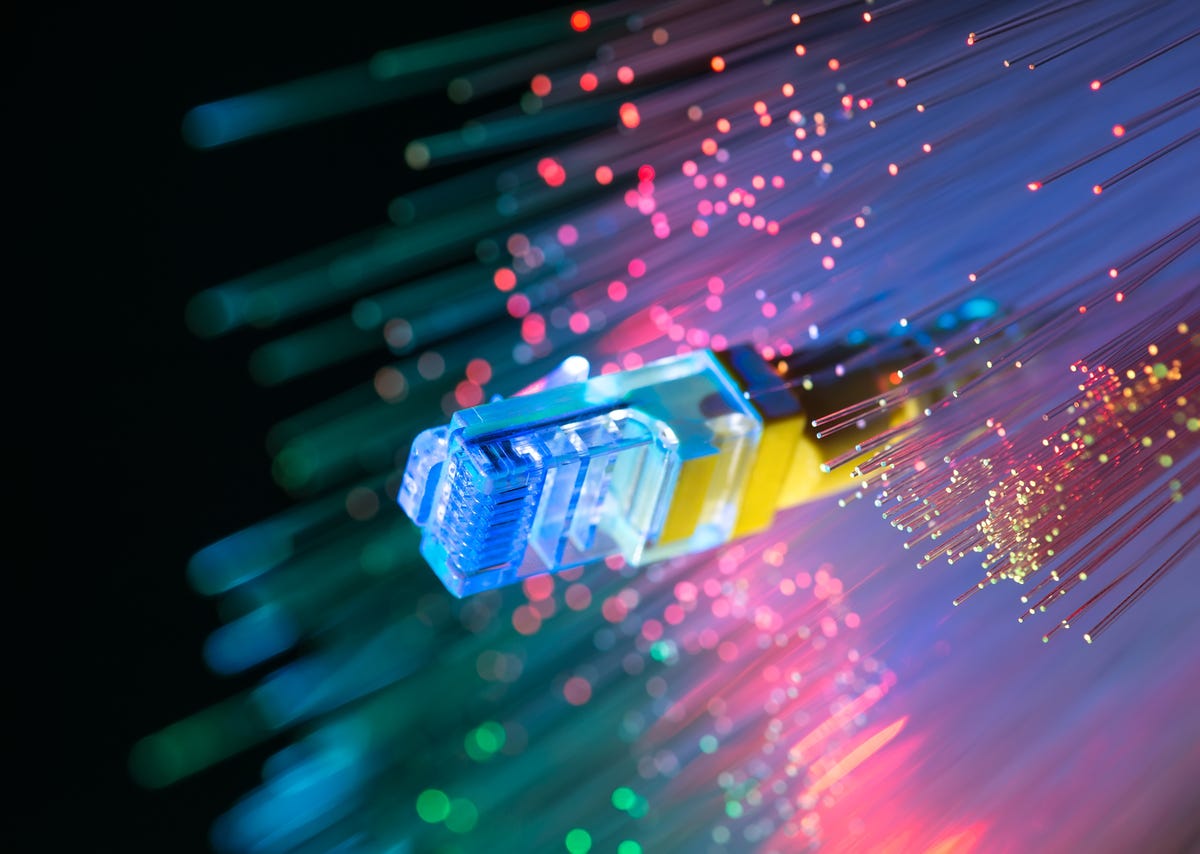50/50 fiber optic speed is comparable to what cable speed

Staying connected in our modernistic world is no longer a simple endeavor. Not just volition you lot be choosing between providers for your internet privileges and remote control rights, y'all'll also have to choose the technology that powers those entertainment sources. DSL, satellite, fiber-optic, and cable are all options for cyberspace and Goggle box service beyond the country, and keeping track of the differences can be a difficult and involved procedure.
While DSL and satellite services have great availability, they can hardly compete with the speed and quality that cobweb-optic and cable connections offer. The deviation betwixt fiber and cablevision is a bit more than nuanced then nosotros've pitted the two advanced services against each other to help y'all navigate your search for the best telco service. The brusk version: Fiber is faster, more reliable, and more than expensive. Cablevision is slower, but it however supports fast speeds and is more widely available.
What'south the difference between cobweb and cable?
Many of the differences between fiber and cable can exist chalked up to the way they transmit information.
Cobweb-optic engineering uses pocket-size, flexible strands of glass to transmit the data equally lite. The strands are wrapped in a bundle and protected with layers of plastic, making fiber faster, clearer, and able to travel great distances. Fiber cables tin can also carry more data than a parcel of copper cables of the same diameter.
For traditional cable, data is transmitted via electricity. Information technology uses coaxial cables to transmit information. Inside that coax cable is a copper cadre insulated with aluminum, a copper shield, and an outer plastic layer. Cable is more susceptible to weather events (like extreme common cold, storms, etc.) and electromagnetic interference than fiber-optic considering it uses electrical signals.
Is there a disparity in quality?
Considering of differences in transmitting technology, fiber-optic services generally offer meliorate quality. Most notably, fiber is faster. Cobweb speeds typically range from 250 Mbps to ane,000 Mbps. Information technology would take yous less than 10 seconds to download a two-hour movie with i,000 Mbps (versus 10+ minutes on a xx Mbps connection). These speeds far outpace the median household internet speed of 72 Mbps (as of September 2017). Fiber-optic cyberspace providers tend to offer symmetrical upload and download speeds, which ways yous tin upload data to the internet just as fast as you can download it. The is extremely unique and will appeal to heavy internet users. If you're constantly uploading information and information (like video conferencing for work or when gaming), this structure could save you a lot of fourth dimension and minimize any lag.
Cable net networks typically offering customers download speeds that range from ten Mbps to 200+ Mbps, although upload speeds are a fraction of those numbers. The higher speed plans are likely to exist enough for about households, based on FCC guidelines and our own enquiry. Cable's lower speed capabilities can cater to smaller households and minimal internet users who only practice a bit of browsing and occasional motion-picture show streaming. But i of the large drawbacks of cablevision technology is that yous share your bandwidth with neighbors: Your speeds will slow during evenings if the whole block is binging the latest season of "Stranger Things". Overall, you lot're looking at a more unreliable network susceptible to more than outside factors.
Is ane more available than the other?
For customers, availability will be the starkest departure between fiber-optic and cable service. The Federal Communications Commission (FCC) has estimated that simply about 14% of the U.S. can access fiber-optic speeds of 1,000 Mbps or more. By the same mensurate, cablevision internet has 88% nationwide coverage at speeds of 25 Mbps or more. That ways you're far more likely to find cable providers who service your address than fiber-optic ones.
Why the exclusivity? Building out fiber engineering science is a long, expensive process. Analysts have estimated that Google Fiber'south early nationwide expansion plan would have cost the company $iii,000-$8,000 per dwelling house. If a provider similar Verizon FiOS has decided to build out service in your neighborhood — yous've essentially won the lottery.
Businesses interested in a fiber connectedness as a individual, secure, and reliable network choice can purchase Direct Cyberspace Access (DIA) fiber and have a defended line built out to the function. Homeowners hoping for fiber will have to cross their fingers and watch the market place.
Is fiber or cable all-time for you?
For most people, cable technology offers cracking entertainment service. Its higher-tier internet speeds can back up a total household of internet users. We'd also recommend cable for people who desire to bundle their services to keep prices down. From what we've seen, fiber's Tv set options are pretty limited, and providers will oft contract another providers Idiot box service in order to offer a parcel. For the best TV programming and bundle deals, you're better off with cable service.
Cobweb speeds are likely more than than most people need right now, but it's worth noting that cobweb is futurity-proof. Every year, the net is becoming more than cardinal to our lives, technology is advancing, and media quality is increasing (from HD to 4K to 8K). Each season sees more 4K streaming content released, which will have more data and speed to run. Nikolai Tenev, the founder of DigidWorks, told us that tech enthusiasts of every kind volition benefit from cobweb — designers, gamers, software engineers, etc. Tenev said, "Gamers ofttimes need to upload video in real-time while playing an online game. Even the slightest drib in connexion or speed can result in them losing the match." If fiber-optic applied science is available to your accost, internet enthusiasts and large households will enjoy the perks the most.
Source: https://www.zdnet.com/home-and-office/networking/fiber-vs-cable-what-is-the-difference/
0 Response to "50/50 fiber optic speed is comparable to what cable speed"
Post a Comment